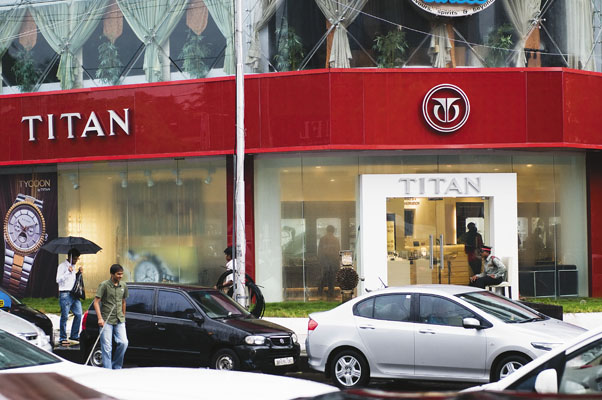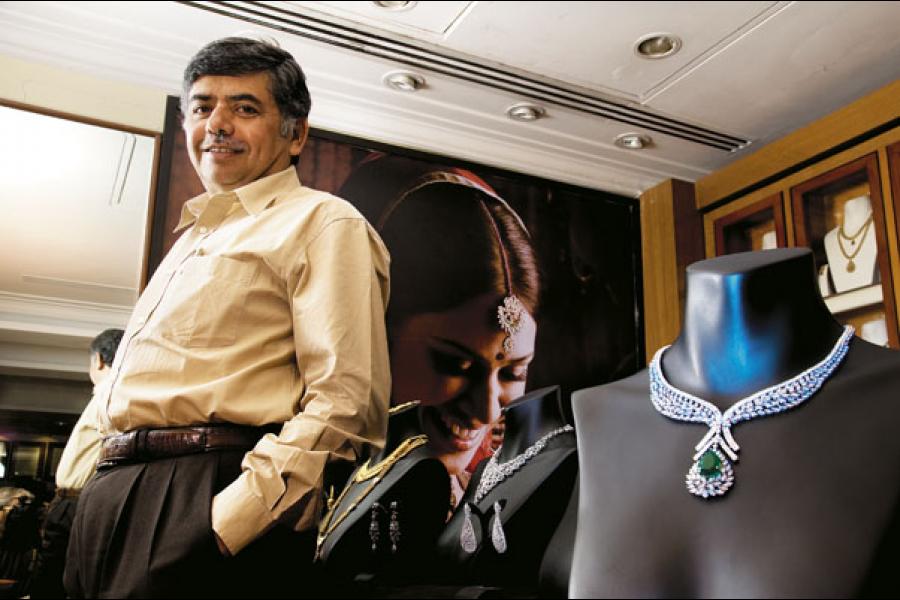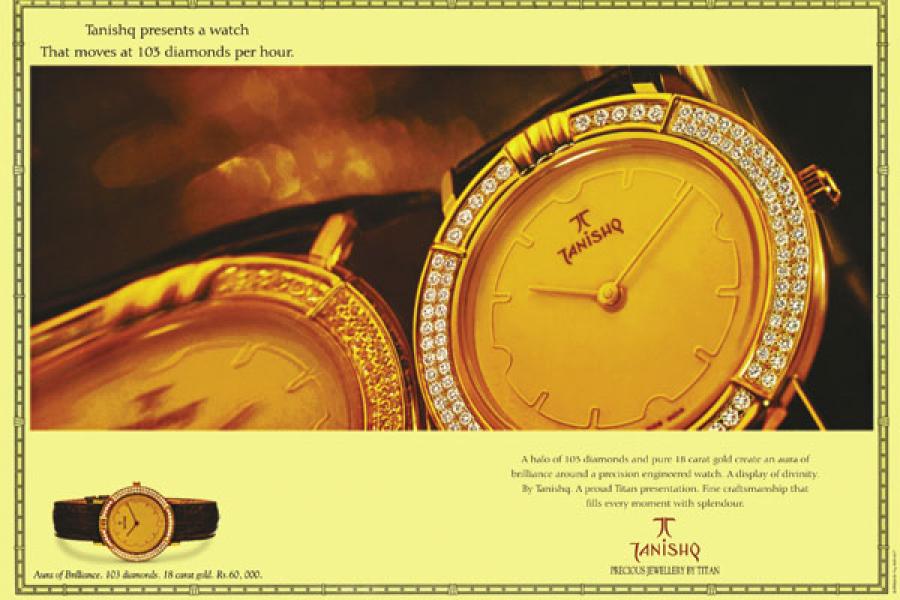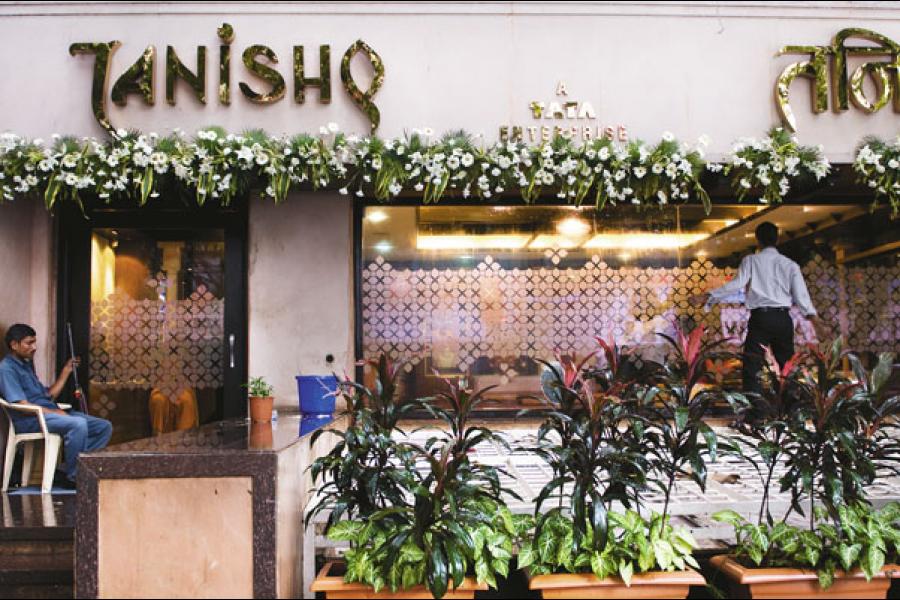
Titan: The Golden Cage
Bhaskar Bhat spent eight years cleaning up the legacy of the 1990s at Titan Industries. Now his new growth plan will need to convince a sceptical board
July-August is a time for special discounts on Usman Road, the main jewelry market in Chennai. Winding queues stretch outside the dozens of shops — some as small as 100 sq. ft. and some as big as 12,000 sq.ft — as women from all over South India converge to buy gold and diamond jewelry well in advance for the marriage season several months later. A flyover keeps the shoppers free from traffic these days.
As one of the biggest jewelry shops on this famous road, the new Tanishq outlet may well mark a shifting preference in the conservative Chennai market towards big format stores.
It is also a take-off point for the new game plan of 55-year-old Bhaskar Bhat, managing director of watches and jewelry maker, Titan Industries. Tanishq has evolved into the Bangalore-based company’s premier business but is now under threat from new competitors with deep pockets. It needs to scale up quickly and gain a substantial market share to avoid being dislodged by them. The mega shop in Chennai, five times the size of a typical Tanishq outlet, will give important clues as to how Bhat can achieve that.
But even to come to this point, Bhat and his team have had to work hard for nearly a decade. Tanishq had once come dangerously close to being nixed as a brand by Titan’s board and the company itself was battling a debt-ridden balance sheet after a failed international expansion. Low profit margins denied him the cash to invest in growth and convincing the board of new plans wasn’t easy.
From there to 2009-10, when Titan Industries crossed a billion dollars in sales with a 23 percent revenue increase and a 39 percent net profit increase, Bhat has come a long way.
Now he has the perfect springboard for taking Titan on an entirely new orbit.
The turnaround was an important psychological victory for Bhat. Titan has been consumed by internal issues, especially by the reluctance of the major shareholders, Tatas (25 percent) and the Tamil Nadu Industrial Development Corporation (Tidco: 27 percent), to infuse more capital.
One set of sources inside the company said the promoters weren’t interested in giving money because they didn’t understand the retailing and lifestyle businesses. But others say that the board didn’t trust the Titan management after finding out that it had not presented a true picture of the losses from the aborted international plan. (This latter assertion could not be ascertained independently.)
Whatever be the past, the results of Bhat’s work have begun to show. Last year Titan’s debt fell below $16 million , the lowest in 20 years and a vast improvement from the days when the company’s debt equity ratio stood at 3:1. The business added Rs. 100 crore of cash to the balance sheet last year. For the first time in many years, Titan has enough money of its own to fund its ambitions. The company’s market value has risen to a record $2 billion. The stock has risen a whopping 133 percent in the last one year.
The Growth Dilemma
Tanishq is the surprise package in the turnaround saga. It brings in 75 percent of Titan’s revenues today and holds the key to its future. However, Bhat has a big unfinished agenda there: Substantially improve its anemic margins. Titan had historically lagged behind its peers in the consumer durable industry like Hero Honda or even Asian Paints on profitability. It took Bhat four years to increase pre-tax profit margins from 5 percent to 7 percent. He aims to take it to 10 percent even while trebling the revenues to Rs. 14,000 crore.
Profitability in the watches business as twice that of jewelry, but the segment is much smaller. Titan is the dominant watch company in India, with 60 percent share. The new prescription eye wear business that Titan launched in 2007 will not break even for some more years. So, the onus of delivering both growth and improving profitability falls squarely on Tanishq.
Till returns substantially improve, Bhat will remain on the back foot while persuading the board to bankroll new projects. For instance, the board was circumspect in giving Bhat the go-ahead to scale up yet another fledgling business: Gold Plus, a brand of pure gold jewelry targeted at the semi-urban and rural market. Titan estimates the market opportunity for Gold Plus at around Rs. 30,000 crore and says initial customer response has been good. Titan has garnered Rs. 449 crore in revenues already. “It’s a good business, because gold perhaps is the only product which has 100 percent penetration in this country,” says Bhat.
However, almost as a throwback to the Tanishq saga, the board isn’t willing to accept the low margins that the business currently generates. “Gold Plus is not a business where Titan can build a differentiated offering. It is largely a commodity business driven by prices. Titan’s strengths are its strong brands,” an independent director says on the condition of anonymity.
(Make sure to listen to our podcast: Titan's Dilemma)
Bhat could always put more pressure on the board to invest in long-term growth even if it means taking a short-term hit. But that’s never been his style. He had the extremely difficult task of filling in the big boots of Xerxes Desai, the iconic leader who founded Titan in 1986. Desai was a towering personality who wielded tremendous influence inside and outside the company. Bhat, who was Desai’s deputy for many years before becoming MD in 2002, is almost the complete opposite. Quiet, understated and thoughtful, Bhat perhaps lacks Desai’s charisma, but he more than makes up in terms of performance.
Bhat seldom takes on the board aggressively, either because he lacks Desai’s stature or because he thinks it is not worthwhile to butt heads with them. The promoters are power houses themselves and the board has always been star-studded. Today, apart from Noel Tata and Ishaat Hussain who represent the Tata group, there are several luminaries as independent directors Nihal Kaviratne, former Chairman of Unilever Indonesia and Vinita Bali, CEO of Britannia.
Bhat knows finding capital will not be easy. “Do we have the appetite for much faster growth? I believe we have,” Bhat says. “But if we grow at a faster pace than this, then we have to go through a period of lower profitability, which we don’t want to right now,” says Bhat. Instead, he needs to find a way to rejig the company’s operating model so that it can deliver both higher profitability and top-line growth, without using up too much capital. But can he pull off the balancing act?
A Close Shave
When Bhat took over the company in 2002, it was in very bad shape. The board felt that Titan’s managers had taken very risky bets and didn’t understand how to keep the overheads low. As a result, the company was never as profitable as it could be. Titan had made a huge investment on a new factory to manufacture watches in Hosur which was necessary in the Eighties. But when outsourcing spread in the next decade, Titan wasn’t quick enough to make the transition. All this time the company had also been borrowing money to fund its international expansion.
With Desai out of the picture, the directors felt they could now take control of the company and undo the mistakes of the past. One of the first things they wanted to do was to close down Tanishq, which was still making a lot of losses. Desai had started the business to export jewelry and fund the international foray. But that didn’t work out too well. International jewelers were not keen to stock Tanishq as a brand and were only interested in outsourcing production. But the money in outsourcing was piddly. It also didn’t make sense because it would be competing with its own suppliers (diamond manufacturers) for these orders.
 STRIKING GOLD Tradition and marriage are the ones bringing the revenue today
STRIKING GOLD Tradition and marriage are the ones bringing the revenue todayThe company then decided to launch Tanishq in India. It was a concept ahead of its time. Indian women preferred to go to family jewelers, just like their mothers and grandmothers had done for years. Habits were hard to break. Tanishq was perceived as a premium, Western brand for modern women. It had a limited range and mostly offered diamond jewelry. Tanishq was losing money every quarter and there was tremendous pressure on Bhat to pull the plug on it.
Jacob Kurien, the former Titan manager who helped start up Tanishq, remembers a crucial meeting with Ratan Tata in Mumbai in 2002. It was a business review of all Tata Group companies and an important meeting to decide Tanishq’s fate. Kurien had taken over as chief operating officer of the jewelry business in 2000. A few months before this meeting, Titan had engaged McKinsey to draw up a feasibility study about its business and its brands. One of McKinsey’s first posers to Kurien was: “Tell us why the jewelry business shouldn’t be shut down.”
Kurien and his team believed they had a solid proposition: With changing lifestyles, aspirations and demographics, the modern woman would move to branded jewelry if the rest of the mix was right.
He said he would be able to turn the business around and made impassioned plea to Tata to give the team some more time to demonstrate results. Tata agreed and Kurien kept his promise. By the time Kurien left Titan in 2003, Tanishq had reached Rs. 560 crore in turnover and was profitable.
As Bhat worked to fix Titan’s problems, he was painfully aware of the lingering question. With Titan making just 5 percent margins, he was still skating on thin ice. The shareholders were unhappy and were in no mood to give him the capital he needed for new businesses and expansion.
Bhat’s task was cut out. After making Titan profitable, he launched a cost-cutting drive and made economic value added (EVA) the mantra for everybody. At last in 2006, he convinced the promoters and raised Rs. 126 crore through a rights issue. By 2008, the businesses had begun to do well and Bhat had enough money for his plans.
The New Game Plan
But today, Bhat is facing his next big challenge. He needs to quickly firewall Tanishq from formidable competition. Ever since Tanishq pioneered the segment, branded jewelry brands have come and gone without making much of a dent into its business. But today, it is being challenged by the might of the Reliance group. Across major malls in the country, Reliance has opened stores very close to Tanishq outlets. And Reliance’s jewelry business is headed by an ex-Titan hand, Bijou Kurien.
With 115 stores in 75 towns, Tanishq is the largest organised sector player in the Rs. 90,000 crore jewelry market. Last year, it had a turnover of Rs. 3,500 crore. That’s a 4 percent market share. But the organised segment is only one tenth of the jewelry business in India. As Titan learnt in the watches business, a brand needs 20 percent market share to achieve a strong position.
That’s why Bhat decided to up the ante. He has set Tanishq a target of Rs. 10,000 crore by 2014-15. He won’t be able to achieve this with his current model of midsize stores. He would need several very large stores like the one on Usman Road, Chennai, to achieve that. “Consumer tastes are now shifting and there is a marked preference for shopping in large stores across product categories,” Bhat says.
Titan plans to open four more stores like that this year alone. “Once we have seven or eight of these big stores, we will be at the tipping point,” says C.K. Venkataraman, COO of the jewelry division. In the next five years, Tanishq will add 50 new stores, of which more than half will be in the middle to large format (between 4,000-18,000 sq. ft.). Venkataraman says a large store of 20,000 sq. ft. needs more investment, but delivers better return on sales than 10 stores of 2,000 sq. ft. each. He says the Chennai store has done well and was profitable from the first month of opening.
The second big thrust will be on the market for weddings-related purchases, which contribute to about 70 percent of total jewelry sales. There, the focus is to develop a portfolio of wedding designs for each community and region and increase the average value of purchase from each customer to about Rs. 2 lakh.
But the boost to the profitability will have to come from diamond jewelry, which typically offers three times the margin that pure gold jewelry brings. Bhat wants to take the share of diamond jewelry revenues to 35 percent from the current level of 27 percent. The surge in gold prices has reduced their gap with diamond jewelry prices making it less difficult for consumers to switch. Tanishq has done its part by launching diamond jewelry for as low as Rs 1,000. “It may not be the best quality diamond, but it’s the price of just four movie tickets,” says Venkataraman.
That’s a game Reliance Jewels — part of Reliance Retail — is already playing. The chain has expanded to 22 stores across the country with a plan to look at 100 stores over the next three years. “Reliance Jewels is not aimed at the premium buyer but is targeted at a much larger segment of the market,” says Bijou Kurien, president and CEO for lifestyle, Reliance Retail. Both the corporate giants will operate from their respective positions of strengths. While Reliance has obvious financial muscle, Tanishq will fall back on its strong brand. This is a battle worth watching.
Meanwhile, Titan has begun working with McKinsey to identify the big areas for growth in the next five years. Titan’s unique combination of brands (nine brands including Tanishq, Titan and Fastrack), retail reach (550 company-owned stores; 685,000 sq. ft. of retail space) and understanding of consumer preferences sets it up well to take advantage of imploding demand for personal lifestyle products, says Harish Bhat, chief operating officer of the watch division. “Titan today is in the right place at the right time.”
 Image: Alok Brahmbhatt
Image: Alok BrahmbhattThis is one of the reasons why the board has backed the prescription eye wear business that Titan launched in early 2007. Largely a retail operation like Tanishq, Titan sells prescription eye glasses, lenses and frames through 82 of its Titan Eye+ outlets. Although Titan Eye+ is yet to break even, Bhat says the business has a huge upside. The market is quite small but is highly fragmented and has low penetration. In a steady state, Bhat says the business yields the same margins as watches (about 14 percent) which make it an attractive play.
On his part, Bhat will be hoping that his managers have learned enough from the Tanishq experience to ensure that the scale-up doesn’t throw the company off the rails yet again.
(This story appears in the 30 July, 2010 issue of Forbes India. To visit our Archives, click here.)
-
 Hiren dand
Hiren dandBhaskar is Bhaskar and he has proved...just need to visit the fastrack stores and see what type of brand it has created---The board in coming times will give him a free hand am sure after all performance speaks and who does not like an Earning son with "No strings attached cash?"
on Jul 24, 2010

















